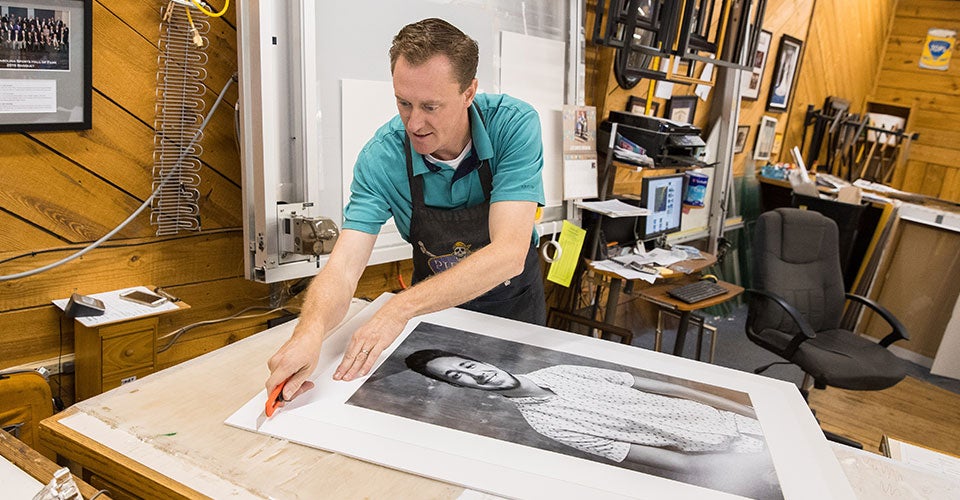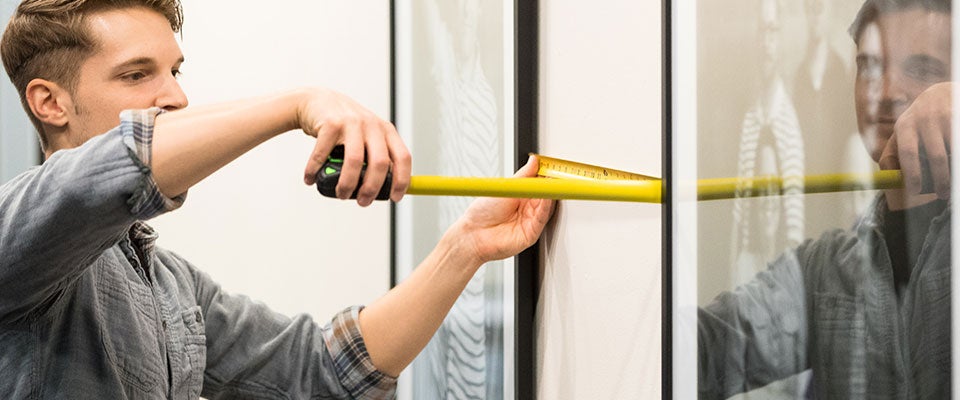TRUE COLORS
Art exhibit shows full spectrum of ECU community
Their faces look out from the walls, captured in crisp black and white, smiling, laughing, welcoming, challenging. They are women, men, friends, couples, families. They are lesbian, gay, bisexual, transgender, straight – and Pirates all.
These faces are part of a new art exhibit featuring 23 photographs of members and supporters of the LGBT community at East Carolina University. The photos – mostly of students but also of alumni, staff and fans – were taken by ECU photography students who volunteered for the project.
“True Colors: Celebrating the Spectrum of Sexual and Gender Diversity,” is open through Oct. 31 in honor of LGBT History Month. The project is a collaboration between the LGBT Resource Office within Student Affairs, and the School of Art and Design.
An opening reception was held Oct. 5 at Mendenhall Student Center, where most of the photos are on display. Some are also at the Brody School of Medicine.
“This exhibit is a vivid photographic journey honoring the rich diversity of our community at ECU,” said Mark Rasdorf, associate director for the LGBT Resource Office.
“There are gay folks all around you – in your dorms, in your labs, studying with you – and we’re pretty much just like you,” says photo subject Dr. Jesse Peel, a retired psychiatrist based in Atlanta and a long-time supporter of the LGBT Resource Office at ECU.
A Martin County native and graduate of the University of North Carolina at Chapel Hill, he supports efforts like this at ECU so that he can have a positive impact on the place he grew up.
“I am so impressed with the courage of these young men and women. I cannot imagine being so out and open when I was their age,” Peel said. “So when they invited me to participate in this exhibit I was honored to join them.”
Rasdorf worked with Angela Wells, assistant professor of photography, to get the project started. The collaboration was a natural fit, he said. The exhibit was funded in part by the Department of Student Involvement & Leadership Co-Curricular Collaborations program. The frames were done by Shenandoah Graphics and Framing. Photos are accompanied by personal statements from the subjects. Another part of the exhibit features biographies of LGBT role models.
Rasdorf got the idea when a colleague e-mailed him about a similar national traveling exhibit, but the cost was prohibitive. This past spring, he struck up a conversation with Wells at a Safe Zone training, where people can talk, learn, and ask questions about sexuality and gender in a non-judgmental and educational environment and is led by the LGBT Resource Office.
“We just thought, why pay all that money for photos of strangers, when we have a really diverse community right here and the resources to make this exhibit happen,” Wells said.
Rasdorf and Wells put out a call for volunteers and got almost 40 people involved with the project. Most of the work – scheduling, taking and printing the photographs – took place over the summer.
“The students were really jazzed,” said Wells. “There was instant enthusiasm. All the students were doing this for the experience, not for class credit. They thought this project was really important.”
Jon Cockerham, a sophomore communication major, is a subject of one of the photos, along with his boyfriend. Cockerham is president of the GLBT Student Union, an independent student organization.
“When Mark asked me, I said ‘Sure, why not?’ I’ve never done anything like this before,” Cockerham said. “Family pictures when you’re a kid are mostly formal and posed. Coming here, we could do what we wanted. It was really cool seeing how all the photos turned out.”
Photography students got valuable professional practice running a photo shoot and putting subjects at ease, according to Wells. Graphic design students also helped create ads and other promotional materials. Overall, it was a perfect opportunity for senior Ashton Tygart.
“As a member of the LGBT community, a graphic designer and photographer, I felt strongly compelled to help,” Tygart said. “Work doesn’t feel like work at all if it’s something that you’re passionate about doing. I am passionate about the art I create and I am passionate about my community. I think I learned the most about working with models and making them comfortable in front of the camera. It’s an essential skill for making photos that both the viewer and participant will enjoy.”
Not only did the students learn a lot, but organizers and participants hope the community will learn something new as well.
“Mark and the kids at the LGBT office have done a wonderful job of bringing the LGBT experience to the forefront at ECU and I am proud of them,” said Peel. “I hope this exhibit will spark conversation about being gay – that it is not some disease or disorder. I hope that people will begin to question their prejudices and their fears and to begin to open their hearts to being more inclusive and accepting.”
Dr. Jitka Virag, an assistant professor in the Brody School of Medicine and a member of the school’s diversity committee, helped arrange for some of the photos to be displayed at Brody.
“We have a diverse population here and we need to celebrate those differences so that we learn to respect an appreciate each other as colleagues and clients,” Virag said. “Only when we learn to understand and embrace our differences will we be able to optimize our health care strategies and improve outcomes.”
Helping people learn about and understand the LGBT community was a major motivator for Tygart.
“I feel the intolerance and bigotry for the LGBT community comes from ignorance,” she said. “The more we put ourselves out there the more, I believe, people will come to realize that if a person is gay or trans… they are just a person.”

J.R. Getz of Shenandoah Graphics and Framing works on framing one of the photos for the True Colors exhibit.
